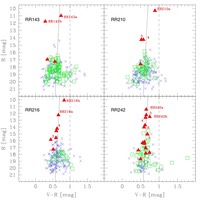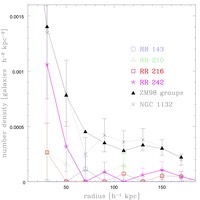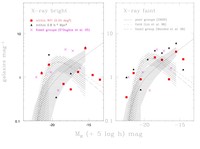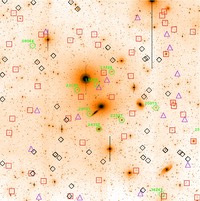Figure 1. Results of VIMOS observations superposed on the RR 242 WFI image. Marked with different symbols are: new groups members (green circles), confirmed background galaxies (red squares), spectroscopically observed candidates too faint for redshift measurement (blue triangles) and spectroscopically not observed objects (black diamonds).
Searching for the faint galaxy population associated with X-ray detected isolated E+S pairs
We present VLT-VIMOS observations in search for faint galaxy members of 4 E+S systems in a FoV of about 0.2 h-1100 Mpc radius (Figure 1). We investigate the morphological and photometric characteristics of the new group members as well as their spectral properties. We use the new data to determine the group dynamics as well as combined group luminosity functions.
We found two and ten new members associated with the X-ray bright systems RR 143 and RR 242 respectively. The X-ray faint RR 210 and RR 216, which are only partially covered by the VIMOS observations, have two and three new faint members respectively. The new members (Figure 2 and Figure 3) increase the number of associated galaxies to 4, 7, 6 and 16 for RR 143, RR 210, RR 216 and RR 242, respectively, down to MR ~ -12 + 5 log h100.
The faint galaxy population of all systems is dominated by disk galaxies, 40% being S0s with generally low bulge to total light ratios. A small fraction of the faint companions show signatures of interaction.
We derived the dynamical properties of the four systems. The analysis indicated short crossing times for all systems suggesting that at least the centres of the groups are virilized. The E pair member dominate the groups: in RR 143 and RR 210 they represent about 1/2 and in RR 216 and RR 242 ~ 1/3 of the total group light. The dynamical quantities appear uncorrelated with group X-ray luminosity. The hot IGM is centred on the E is shifted from the optical group centre. The X-ray emission then seems connected with the bright E and its evolutionary phase rather then with the group environment.
We derived the optical luminosity functions (OLF) of the four groups. A comparison between the OLFs of our E+S systems and a sample of X-ray bright poor groups sugegst that the OLF of X-ray detected poor group of galaxies is not universal in contrast to the results of Zabludoff & Mulchaey (2000). The OLF of our X-ray bright systems suggests that they are more dynamically evolved than our X-ray faint sample and some X-ray bright groups in the literature. However, we suggest that the X-ray faint E+S pairs represent a phase in the dynamical evolution of some X-ray bright groups. The recent or ongoing interaction in which the E member of the X-ray faint pairs is involved could have decreased the luminosity of any surrounding X-ray emitting gas.
Interaction induced rejuvenation episodes may be present in a small fraction of our sample as suggested by the presence of fine structures in few faint members. The E members in both RR 210 and RR 216 are also good candidates for showing rejuvenation signatures in their stellar population. This finding would reinforce our hypothesis that their faint X-ray emission is connected with the phase of their dynamical evolution. The presence of a young stellar population in both the giant and the faint galaxy members can be ascertain through the study of absorption line-strength indices that is in preparation.
more details in
Grutzbauch R., Zeilinger W.W., Rampazzo R., Held E.V., Sulentic J.W., Trinchieri, G.
Small-scale system of galaxies. IV. Searching for the faint galaxy population associated with X-ray detected isolated E+S pairs
2009, A&A, 502, 473



